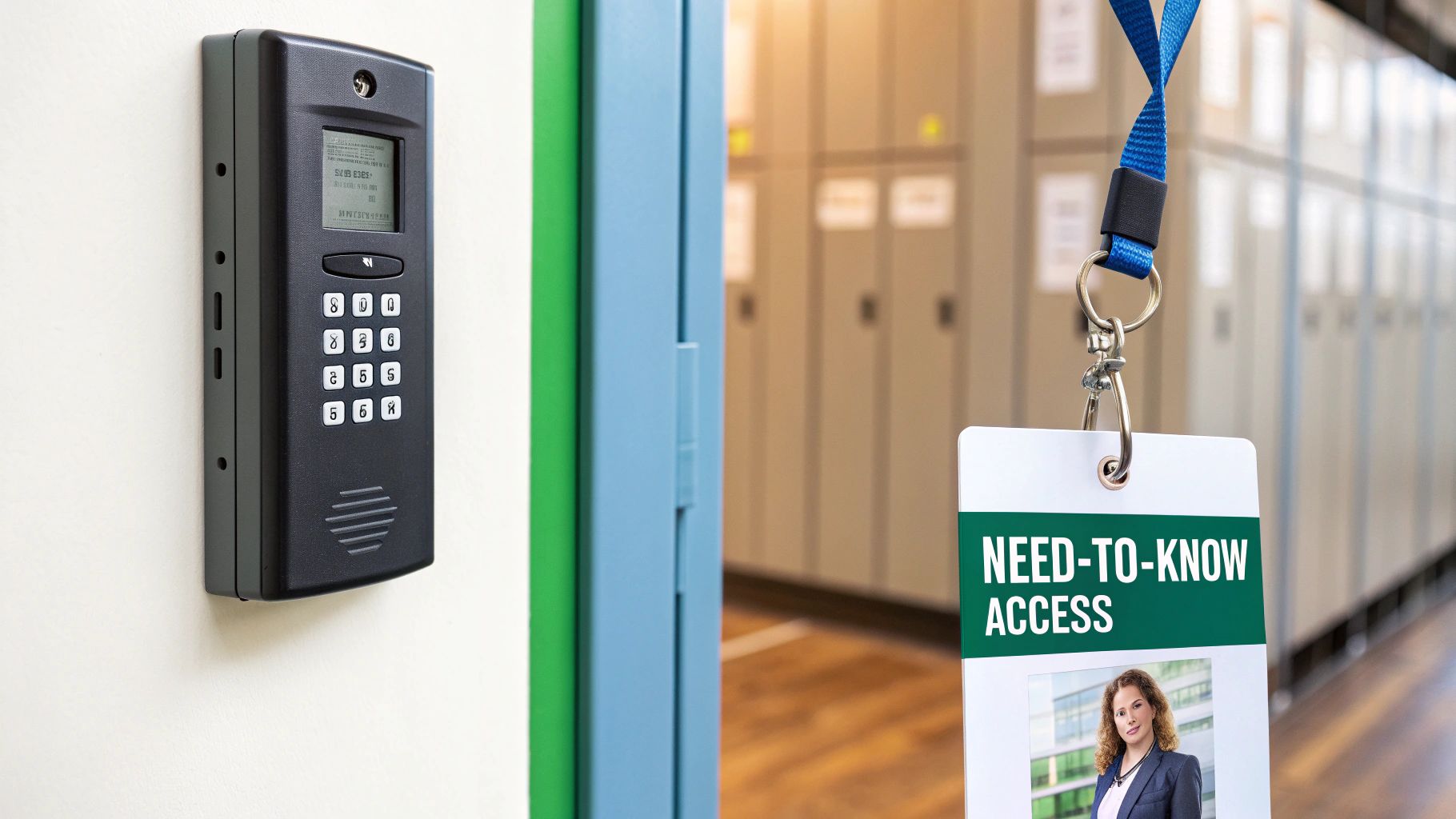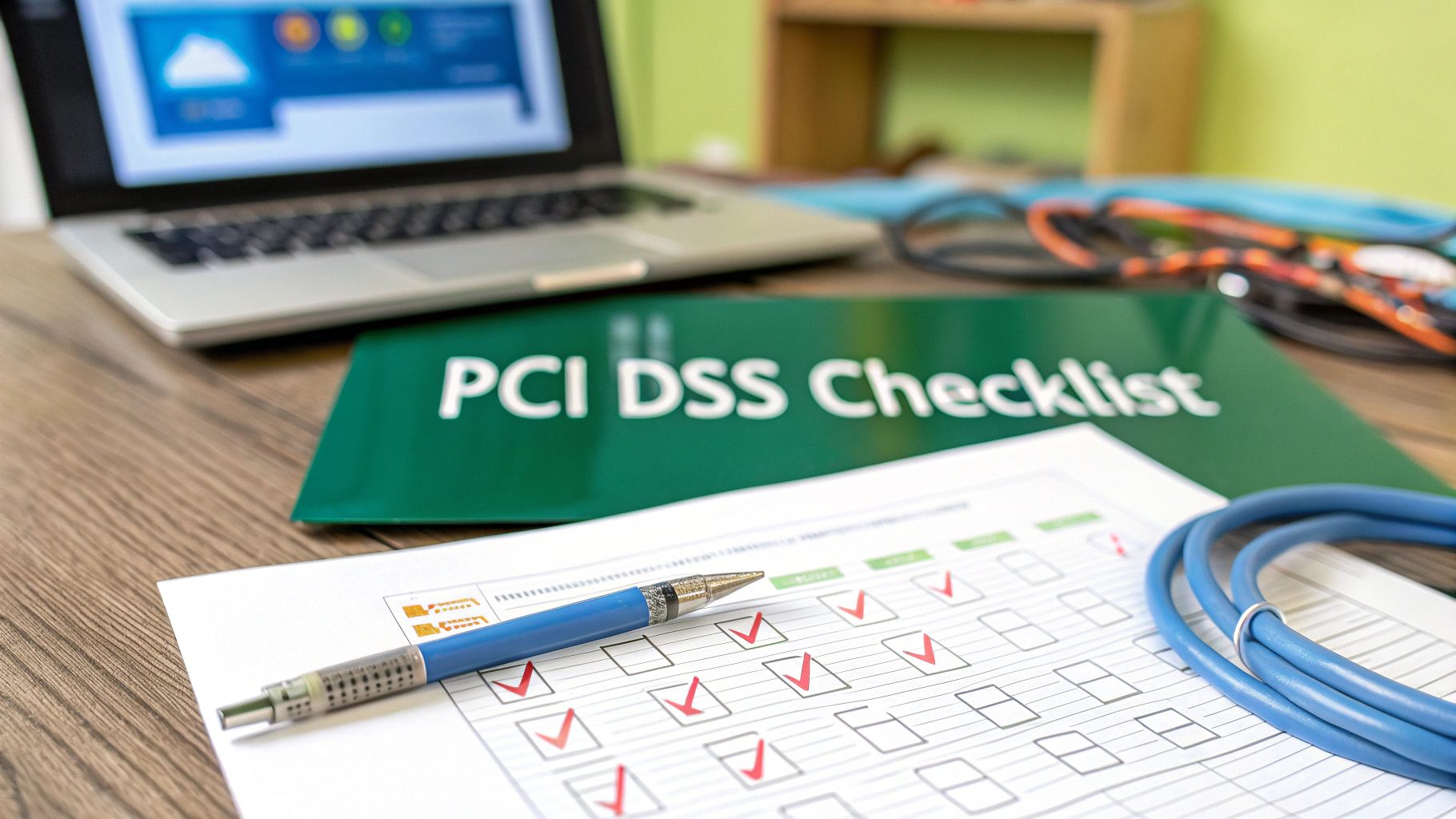Navigating the Payment Card Industry Data Security Standard (PCI DSS) is a headache. You need to protect customer data to keep your business running, but the requirements are complex and audits are stressful. Failing an audit means big fines, losing your ability to process payments, and destroying customer trust.
This guide is your straightforward PCI DSS compliance checklist. We'll break down the 12 core requirements into simple, actionable steps. No jargon, no fluff—just what you need to do to secure your data, pass your audit, and get back to business.
Think of this as your roadmap. It's for IT managers, CISOs, and founders who need compliance without the high costs and slow timelines of traditional security firms. Let's get it done.
Build and Maintain a Secure Network and Systems
The first step in any PCI DSS compliance checklist is to build a wall around your customer's data. This means installing and maintaining a strong firewall to protect your cardholder data environment (CDE). A firewall is like a security guard for your network, checking all traffic and blocking anything suspicious based on rules you set.
This is non-negotiable. Without a good firewall, your sensitive data is wide open to attackers. You need to document every rule, apply a "deny-all" default, and review your firewall logs constantly. Make sure you use robust network security monitoring tools to automate alerts and catch threats fast.
Do Not Use Vendor-Supplied Default Passwords
The second critical task is to get rid of default passwords on all your equipment. Attackers love defaults like "admin/admin" because they provide an easy backdoor into your systems. You must change every default password and setting on routers, servers, and software before they go live.

Leaving defaults is like leaving the key under the mat. It’s an open invitation for a breach. The fix is simple: inventory all your hardware and software, change the passwords, and disable any default accounts you don't need. Use a password manager and create strong information security policy templates to make sure your team follows the rules.
Protect Stored Cardholder Data
If you don't need cardholder data, don't store it. If you do, you must protect it with strong encryption. Requirement 3 of the PCI DSS compliance checklist is all about making stored data unreadable and useless to thieves. This includes data in databases, log files, and backups.
Tokenization is another great option, where the actual card number is replaced with a unique, non-sensitive token. This drastically reduces your risk because you're no longer storing the real data. The goal is to make sure that even if attackers get in, they walk away with nothing valuable.
Encrypt Cardholder Data in Transit Across Open Networks
Data is most vulnerable when it's moving. This requirement mandates using strong encryption, like Transport Layer Security (TLS), to protect payment information as it travels across networks like the internet. This wraps the data in a secure layer so it can't be intercepted.
Sending unencrypted data is like mailing a postcard with a credit card number written on it. You must disable old, weak protocols like SSL and early TLS. Stick to TLS 1.2 or higher, use strong cipher suites, and keep your SSL/TLS certificates up to date. This is a basic but critical step for any e-commerce site or payment API.
Protect All Systems Against Malware
You need an active defense against malware. This means deploying and regularly updating anti-virus software on all systems, especially those that are commonly affected by malicious software. This isn't just a "set it and forget it" task; your anti-virus must be actively running, scanning, and generating logs.
Your vulnerability management program plays a huge role here. Hackers exploit known bugs to deliver malware, so patching your systems is just as important as having anti-virus. A fast penetration testing engagement can find these weak spots before attackers do, giving you a clear roadmap for remediation.
Develop and Maintain Secure Systems and Applications
Security should be baked into your systems and applications from day one, not bolted on as an afterthought. This means following secure coding guidelines, protecting against common vulnerabilities like SQL injection and cross-site scripting (XSS), and having a process to manage security patches.
This is where a solid vulnerability management program becomes essential. Regular security testing, including both automated scans and manual penetration testing, helps you find and fix flaws before they become a major problem. For compliance-specific testing like SOC 2 penetration testing, this is a non-negotiable requirement.
Restrict Access to Cardholder Data by Business Need-to-Know
Not everyone in your company needs access to sensitive customer data. This part of the PCI DSS compliance checklist is about the principle of least privilege: give people access only to the data they absolutely need to do their jobs. It shrinks your internal attack surface and limits the damage if an employee's account is compromised.

Start with a "deny-all" policy and only grant access on a case-by-case basis. You need to document who has access to what and why. Regularly review these permissions, especially when employees change roles or leave the company. This simple discipline prevents data overexposure.
Identify and Authenticate Access to System Components
Every person who accesses your systems must have their own unique ID. Shared accounts like "admin" or "support" are forbidden because they make it impossible to track who did what. This requirement ensures accountability by tying every action to a specific individual.
In addition to unique IDs, you must enforce strong password policies and use multi-factor authentication (MFA) for all remote access and for any administrator accessing the CDE. This creates multiple layers of defense, making it much harder for an attacker with a stolen password to get in.
Restrict Physical Access to Cardholder Data
Your digital security is useless if someone can just walk into your server room and grab a hard drive. This requirement is about securing the physical locations where cardholder data is stored. This includes using locks, video surveillance, and visitor logs to control access to data centers and other sensitive areas.
Only authorized personnel should be allowed in these areas, and their access should be logged. You also need secure procedures for handling and destroying media like paper printouts and old hard drives. Physical security is a foundational layer of defense that can't be overlooked.
Track and Monitor All Access to Network Resources
You can't protect what you can't see. This requirement is about logging everything. You need to track all access to network resources and cardholder data, creating a detailed audit trail. These logs help you detect suspicious activity and are critical for investigating a security incident.
Use a Security Information and Event Management (SIEM) system to centralize your logs and set up real-time alerts for potential threats. You also need to review these logs regularly. Just collecting them isn't enough; you have to actively monitor them to spot problems before they turn into a full-blown breach.
Regularly Test Security Systems and Processes
Compliance isn't a one-time project. You must regularly test your security controls to make sure they are working as expected. This includes running quarterly vulnerability scans, performing annual penetration testing, and monitoring for unauthorized wireless access points.
This is where affordable penetration testing becomes a game-changer. Unlike slow, expensive firms, we provide fast penetration testing services delivered by OSCP and CEH certified experts. We find your security gaps quickly so you can fix them and get your compliance reports without delay. Don't wait for an audit to find your weaknesses; test them yourself first.
Maintain an Information Security Policy
Finally, you need a formal information security policy that sets the tone for your entire organization. This policy should clearly define security responsibilities for all personnel and be reviewed at least once a year. It's the document that ties all your other security efforts together.
Your policy must include an incident response plan that outlines exactly what to do in case of a data breach. Having a plan ready before you need it is crucial for a fast, effective response. Check out our guide on security incident response planning for more details.
Get Your PCI Pentest Done Fast and Affordably
You've gone through the PCI DSS compliance checklist, but checking boxes isn't enough. You need to prove your controls work under pressure. That's what a penetration test does—it validates your security in the real world. Traditional pentesting firms are slow and expensive, often taking weeks and costing over $15,000. That's a deal-breaker for most businesses.
At Affordable Pentesting, we do things differently. We deliver high-quality, OSCP-certified penetration testing services without the ridiculous price tag or long wait times. Our PCI pentests start at just $4,999, and we deliver your full report in as little as five days. We're built for companies that need urgent penetration testing to meet compliance deadlines.
Don't let a slow, overpriced pentest derail your PCI audit. We provide the fast, affordable penetration testing you need to get compliant and secure your business. Get in touch through our contact form for a no-nonsense quote today.
.svg)
